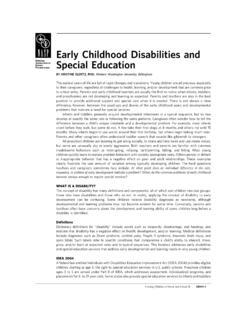Transcription of OCCUPATIONAL SAFETY & HEALTH ADMINISTRATION (OSHA)
1 Welcome WELCOME . Employees being struck by vehicles or mobile equipment lead to many work zone fatalities and injuries. A. work zone activity is dangerous business. This is not the place to cut corners or cheat on SAFETY . It's your life on the line, so pay attention and know what it takes to keep you safe. This publication contains: 1. The purpose for the OCCUPATIONAL SAFETY and HEALTH ADMINISTRATION (OSHA). and its enforcement duty under law. 2. An explanation of the Manual of Uniform Traffic Control Devices (MUTCD). and how it's used to enforce worker SAFETY . 3. Important terms and definitions within the Manual of Uniform Traffic Control Devices (MUTCD). 4. Requirements for high visibility SAFETY apparel. 5. Procedures for how to set-up, maintain and inspect temporary traffic control work zones and devices. 6. Training requirements for those who work in and around traffic, streets and highways, including flagger qualifications.
2 7. Emergency planning and response procedures for work zone operations. This program is dedicated to all the workers who have lost their lives in work zones. Work Zone Hazards Workbook 8/08 i Acknowledgements & Credits This publication was produced by: Construction SAFETY Council 4100 Madison Street Hillside, IL 60162. (800) 552-7744 Copyright 2008. The Construction SAFETY Council will like to thank the following for their contributions and support: The OCCUPATIONAL SAFETY and HEALTH ADMINISTRATION (OSHA). The National Institute for OCCUPATIONAL SAFETY and HEALTH (NIOSH). The Underground Contractors Association of Illinois The National Work Zone SAFETY Information Clearinghouse The Laborers' Training and Education Fund Special thanks to: The American Traffic SAFETY Services Association 15 Riverside Parkway, Suite 100. Fredericksburg, VA 22406. GENERAL DISCLAIMER.
3 This material is intended for training purposes only. Its purpose is to inform employers and employees of best practices in work zone SAFETY . This material is not a substitute for any provision of the OCCUPATIONAL SAFETY and HEALTH ADMINISTRATION (OSHA) or any standards issued by OSHA. If at any time it is discovered that the materials presented vary from Federal or State OSHA regulations, American National Standards Institute (ANSI), EPA regulations, state laws or local ordinances, it is understood that those regulations, laws and ordinances will take precedence over the materials presented herein. In some cases, the information given may imply a higher level of protection then required in some Federal or State OSHA. regulations. The mention of any products or materials by brand name in no way constitutes endorsement. Any products or materials not mentioned within this manual that may be considered acceptable as protective devices, equipment, or practices is not intentional and should not rule out their acceptability as employee or environmental protection.
4 OSHA DISCLAIMER. This material was produced under grant number 46E6-HT18 from the OCCUPATIONAL SAFETY and HEALTH ADMINISTRATION , Department of Labor. It does not necessarily reflect the views or policies of the Department of Labor, nor does mention of trade names, commercial products, or organizations imply endorsement by the Government. Work Zone Hazards Workbook 8/08 ii Table of Contents Page Introduction to OSHA 1. Introduction to the MUTCD 3. Worker SAFETY Considerations 5. Competent Person & Training 6. High Visibility SAFETY Apparel 7. Temporary Traffic Control Zones 8. Advanced Warning Area 10. Transition Area 11. Activity Area 13. Traffic Control Devices 14. Flagger Qualifications 17. Flagger Operations 18. Internal Traffic Control Plan 19. Motor Vehicle SAFETY 21. Emergency Planning & Response 22. MUTCD References 23. Work Zone Hazards Workbook 8/08 iii Course Description OVERVIEW.
5 In this course, students will learn about the role and responsibility of the employer to train all workers whose job brings them in or close to traffic; this work may take place on a street, highway or anywhere where the motoring public will have access, parking lots, access roads, etc. In addition to the safe work practices and procedures involved with the motoring public external traffic control, a special look at the hazards involved with on-site construction related traffic will also be addressed internal traffic control. External Traffic Control The primary function of temporary traffic control (TTC) is to provide for the reasonably safe and efficient movement of road users through or around work zones while protecting workers. Internal Traffic Control An internal traffic control plan (ITCP) is a tool that an employer can use to coordinate the flow of construction vehicles, equipment, and workers on foot moving in close proximity to each other within the work zone.
6 Topics include the understanding and application of definitions relating to work zone SAFETY , including terms used in the Manual of Uniform Traffic Control Devices. At the conclusion of this course, the participant will be able to apply new knowledge and skills that are necessary in selecting, inspecting and maintaining a properly set up work zone. INTENDED AUDIENCE. The target audience is the contractor, manager, employee or employee representative who works in and/or around public or on-site vehicular traffic, including but not limited to: State and local highway agencies, public officials, the insurance industry, law enforcement agencies, incident management personnel, maintenance personnel, academic institutions, private industry, and construction & engineering organizations. Work Zone Hazards Workbook 8/08 iv Notes _____. _____. _____. _____. _____. _____.
7 _____. _____. _____. _____. _____. _____. _____. _____. _____. _____. _____. _____. _____. _____. _____. _____. _____. Work Zone Hazards Workbook 8/08 v Notes _____. _____. _____. _____. _____. _____. _____. _____. _____. _____. _____. _____. _____. _____. _____. _____. _____. _____. _____. _____. _____. _____. Work Zone Hazards Workbook 8/08 vi Introduction to OSHA. OCCUPATIONAL SAFETY & HEALTH . ADMINISTRATION (OSHA). Part of the Department of Labor (DOL), OSHA is the authority for protecting worker's HEALTH and SAFETY on the job; its mission is to eliminate on-the-job injuries, illnesses and fatalities. OSHA accomplishes its mission by setting and enforcing standards; providing training, outreach, and education;. establishing partnerships; and encouraging continual improvement in workplace SAFETY and HEALTH . For more information on OSHA, visit their website at Because of the continuing incidence of work zone crashes and accompanying loss of life, the agency has determined that an ongoing OSHA enforcement presence at worksites where such operations are being conducted is warranted.
8 WARNING! OSHA compliance officers are driving around looking for work zone activities and will stop to conduct an inspection if unsafe conditions are noticed. Work Zone Facts During peak construction season, approximately 20% of our nation's highway system is under construction with more than 3,000 work zones. Approximately 12 billion vehicle miles of travel a year will be through active work zones. Motorists can expect to encounter an active work zone 1 out of every 100. miles driven on the nation's highway system. More than 40,000 people are injured each year as a result of crashes in work zones. o One work zone fatality every 8 hours 3 per day o One work zone injury every 9 minutes 160 per day Source: The National Work Zone SAFETY Information Clearinghouse Work Zone Hazards Workbook 8/08 1. Introduction to OSHA. OSHA STANDARDS ON WORK ZONES. The OSHA standards that regulate work in traffic are found in 29 CFR 1926.
9 Subpart G; these are the Federal OSHA requirements (consult State plan requirements where applicable). 29 CFR What? What do all those numbers and letters mean? (Department of Labor) (Code of Federal Regulations) (Construction Industry) (Signs, Signals, and Barricades). 29 CFR (g) Traffic Signs. (1) Construction areas shall be posted with legible traffic signs at points of hazard. (2) All traffic control signs or devices used for protection of construction workers shall conform to Part VI of the Manual of Uniform Traffic Control Devices (MUTCD). 29 CFR (a) Flaggers. Signaling by flaggers and the use of flaggers, including warning garments worn by flaggers shall conform to Part VI of the Manual of Uniform Traffic Control Devices (MUTCD). NOTE: Warning garments must meet the requirements of ANSI 107 for high visibility SAFETY apparel, see page 7. Work Zone Hazards Workbook 8/08 2.
10 Introduction to the MUTCD. WORK ZONE SAFETY STANDARDS. The Manual on Uniform Traffic Control Devices (MUTCD) defines the standards used by road managers nationwide to install and maintain traffic control devices on all streets and highways. The MUTCD is published by the Federal Highway ADMINISTRATION (FHWA), incorporated by the Department of Transportation (DOT) and referenced by the OCCUPATIONAL SAFETY and HEALTH ADMINISTRATION (OSHA). The MUTCD sets minimum standards, provides guidance and ensures uniformity of traffic control devices across the nation. The use of uniform traffic control devices (messages, location, size, shapes, and colors) helps reduce crashes and congestion, and improves the efficiency of the surface transportation system. The information contained in the MUTCD is the result of years of practical experience and research. This effort ensures that traffic control devices are visible, recognizable, understandable, and necessary.

















